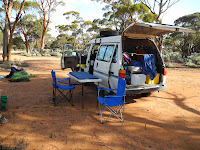Cash
in on your Carobs! Sell the dried beans from your tree for profit for your
organization or for pocket money for the kids.
George (of the two Georges fame) asked if all you growers of carob trees
together with clubs whose members know someone with carob trees and would like
to raise funds, get busy at harvest time and start gathering the beans for
sale. Harvest starts from late January in Geraldton. He told me that there are
people in Geraldton who are willing to buy ripe carob beans for processing in
the plant they showed off at a recent Mingenew expo.
Here are the details George asked
me to pass on to you;
‘Carob Fruit Pod/Harvest’
‘If
you could get the kids when on school holidays when they want a bit of pocket
money/ a few dollars to support your local sports club/youth club, then why not
pick the ripe Carob fruit on the tree in your back yard?
We
would be most interested in buying the ripe dark brown Carob pods.
The
Carob pods should start dropping just after Christmas and in January.
You
can drop off the fruit at the public weighbridge at Central Metal Recyclers,
190 Gould’s Road, Narngulu, tel: 9923 3698.’
About
this amazing tree;
The
carob is a slow growing, long living, evergreen tree that is well suited to
dry, harsh climates with infertile soil. They can produce for up to a hundred
years and the broad leaves offer lots of shade in summer. The fruit is a
brownish coloured pod which can grow up to a foot long. Locust bean gum is
extracted from the seeds. The pods can be used in chocolate.
They
are high in energy and make a good stock feed supplement.
The
tree is nitrogen fixing and can improve soil fertility. It could be included in
programs for sustainable agriculture. Little or no chemical treatment is needed
for its cultivation while its feeding needs are minimal.
They
will bear fruit from seven to ten years after planting the seed, but cuttings
planted under irrigation can produce in less than three years. The fruit is dark brown when it is ready for
picking but not when it is a green colour. Ancient harvesting methods used a
bamboo pole to gently bump the fruit off and nets were placed on the ground to
catch it.
The pods make up 90% of pulp and
the seeds the other 10% so nothing is lost. The product is organic by nature as
little man made interference affects the tree or the fruit.
Back in the dark days of world
war two, when we were little kids living on ‘Womarden’ about three miles out of
Three Springs, we would stay in town each Friday and visit my Aunt’s place for
the afternoon. In the back yard I remember this huge Carob tree and the dark
brown beans lying all around the base. We never tried to eat the seeds but were
told it was OK. The tree was good to climb and hide in!


















